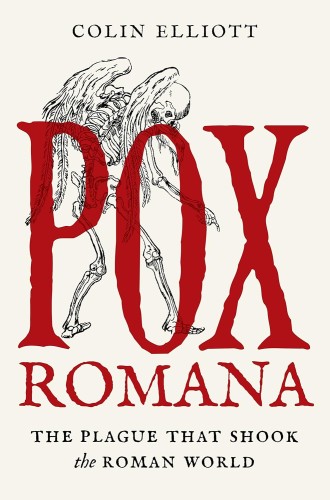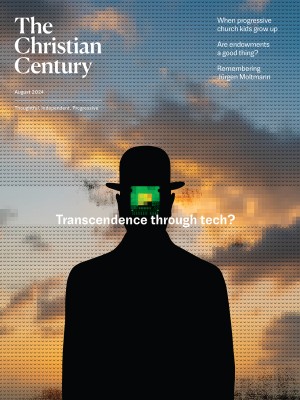Another reason Rome fell
When the Antonine Plague hit in 165, says historian Colin Elliott, the Roman Empire was already well on its way to failure.

Pox Romana
The Plague That Shook the Roman World
Colin Elliott has written a model account of one of the great catastrophes to strike the ancient world: the Antonine Plague that swept the Roman world between 165 and the 180s, killing millions. The culprit disease was probably not plague in any technical sense; it may have been smallpox. Elliott claims this episode as “the world’s first pandemic,” and he places it firmly in the context of a wrenching climatic change that occurred about this time (likely related to the El Niño-Southern Oscillation). As scholars study such convulsions and the pandemics with which they are so intimately linked, they increasingly acknowledge their influence in driving change, in causing the rise and fall of empires, in triggering far-reaching social change. Pox Romana is firmly in this tradition, and Elliott does a superb job of mobilizing all the (very limited) available texts for the period, deftly supplementing them with archaeological and legal materials. Throughout, he is rightly hypercritical in assessing and deploying such evidence.
Pox Romana offers a fine example of how to trace the effects of the crisis as far as the evidence will allow, without presenting that biological onslaught as a one-virus-fits-all explanation. Just what that impact was demands careful discussion, as the plague coincided with what is normally thought of as the absolute peak of Roman power and prestige. I like to imagine the publishers asking Elliott for an eye-catching subtitle for the book, something perhaps like “The Plague That Brought Down Ancient Rome,” only to have him answer responsibly that no, it did nothing of the sort. In fact, Edward Gibbon famously declared that “the period in the history of the world during which the condition of the human race was most happy and prosperous” could be dated to the years between AD 96 and 180, when “the vast extent of the Roman empire was governed by absolute power, under the guidance of virtue and wisdom.” No major downside to that then, apart from those millions of corpses. The empire certainly did suffer an agonizing period of decline and near collapse in the mid-third century, but that was long after the Antonine Plague had concluded.
Read our latest issue or browse back issues.
Before we can talk about the plague’s consequences, we really must understand what came before—and perhaps Elliott’s greatest contribution is to confront that Gibbon-influenced view of the second century as such a glorious period. As Elliott shows in grim detail, the empire was suffering in multiple ways long before the plague hit. Conditions in the swelling cities were poor and colossally unhygienic, diseases of all kinds were endemic, and natural disasters and famines were frequent. Filthy and ill-nourished populations created a wonderful environment for any opportunistic disease. Greatly aggravating matters was the lengthy series of wars which put enormous strains on the state and on society at all levels. Almost certainly, it was soldiers returning from the Near East who brought with them the ailment that exploded into the Antonine Plague. From that perspective, it was not a case of the pandemic destroying any supposed Roman stability but rather making an already bad situation much, much worse. Hence Elliott’s modest subtitle about “shaking the Roman world.”
Not for the first time, when we read such accounts, we realize that we ask the fundamental question the wrong way round. It was not “Why, at any given point, did the Roman Empire fall?” but rather “How on earth did it stagger on as long as it did?”
For historians of Christianity, such ancient pandemics have a special fascination because of analogies with the much better known Plague of Cyprian that swept the empire between 250 and 270. That disaster takes its name from the bishop of Carthage, who described it in horrific detail. Many historians, including myself, have argued that the response to that plague gave a mighty boost to the emerging faith, as Christian believers won such gratitude for caring for the sick, while pagans abandoned their friends and kin. However intuitively plausible (and attractive) such claims might seem, we must never forget that they are based on only a handful of recorded observations which stem from highly partisan and polemical sources with a strong vested interest in exalting Christian values and doing down paganism. But, for the sake of argument, assume that the claims are true and that Christians benefited from their heroic conduct during plagues. Can we see any precedents to all this during the Antonine Plague?
Although admittedly relying on a narrow range of sources, Elliott offers a substantial discussion of Christian responses to the Antonine crisis. He describes the common scapegoating of Christians and the outbreaks of localized persecution targeting those deviants who supposedly had provoked the disasters. Rather to my surprise, given his take-no-prisoners attitude to the stereotypes of the era, Elliott largely accepts the view that Christian distinctiveness would have benefited the new faith in the long run. “The church’s sacrificial care for the sick and dying would have spoken volumes to non-Christian communities,” he writes. “Christians could point to their faithfulness in the midst of epidemics as evidence of their agape love and therefore of the effectiveness of Christ’s own selfless sacrifice to liberate their once sin-stained souls.” Coming from such a skeptical source, these statements are powerful indeed.






